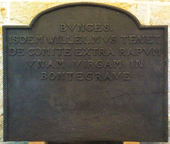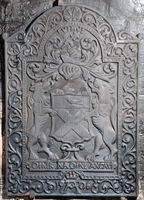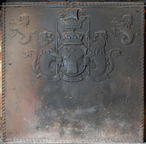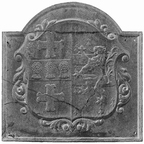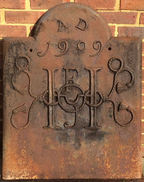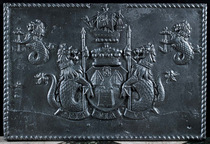-
1206
Description: Arched rectangular shape; twisted rope edging (top and sides); top, centred, text in five lines uppercase with the letter 'U' represented as 'V'.
Notes: Apart from the word 'Bunces' the text is an expanded transcription of the entry in the Domesday Book for Birch Grove, south of East Grinstead. Allegedly it was the author, Rudyard Kipling, who suggested to the then owner of that property that the text be used to decorate a fireback.
Inscription: BVNCES. / ISDEM WILLELMVS TENET / DE COMITE EXTRA RAPVM / VNAM VIRGAM IN / BONTEGRAVE
- Decoration tags:
- rectangular with round arch (shape)
- rope (edging)
- whole carved pattern
- text
Manufactured: in the early-20th century in England.
Current location: in private hands, Horsted Keynes, West Sussex, England.
- Attached to series:
- Commemorative firebacks
-
275
Description: Arched rectangular central panel with indented arch at bottom; bead within double fillet edging; shield, helm, crest and supporters of Bruce, of Duffryn, Glamorgan; 'Fuimus' inscription above crest; motto in rectangular panel below arms; arched rectangular border with fillet edging; scrolled tendril decoration all round, except at centre bottom where is inserted crowned 'A' between halves of date; mirrored scrolls above shoulders of plate.
Notes: A modern plate in traditional style; the arms are of Henry Campbell Bruce (1851-1929), the second baron, who succeeded to the title in 1895. Copies of this fireback were advertised in Kings Worthy Foundry's (Winchester) catalogue in the mid-20th century.
Copies of this fireback are known.
Inscription: FVIMVS [We have been] / OFNER NA OFNE ANGAV [Fear him who does not fear death] / 19 A 06
Arms: Henry Campbell Bruce, 2nd Baron Aberdare
- Decoration tags:
- rectangular with round arch (shape)
- fillet (edging)
- whole carved pattern
- armorial
- text
Manufactured: in 1906 in England.
Current location: Tottington Manor, Edburton, West Sussex, England.
- Attached to series:
- British 'Dutch' style firebacks
- Personal armorial firebacks
-
276
Description: Arched rectangular shape; cavetto moulding all round; spreading oak tree, with leaves and acorns, filling the whole plate; three royal crowns, one at the top of the tree, the other two symmetrically on the ends of branches towards the top corners; initials GR towards the bottom corners, the remaining inscription on a scroll across the base.
Notes: The design is derived from the celebrated occasion when Charles II evaded his pursuers by hiding in an oak tree at Boscobel House, near Wolverhampton, following the final Royalist defeat at the battle of Worcester in 1651. This popular fireback has been copied frequently, and in this recast example the inscription has been re-modelled, with the traditional CR (for Carolus Rex) replaced by GR (for Georgius Rex - George V). Copies of this fireback were advertised in Bratt Colbran Ltd.'s (London) catalogue in the early-20th century.
Inscription: G THE ROYALL OAK R
- Decoration tags:
- rectangular with round arch (shape)
- cavetto (edging)
- whole carved pattern
- pictorial
- royal
- text
- plants
Manufactured: in the early-20th century in England.
Current location: Chequers, Ellesborough, Buckinghamshire, England.
- Attached to series:
- Commemorative firebacks
-
1132
Description: Cavetto-canted arched rectangular shape; rebated wide fillet edging; shield of Llewellyn impaling unidentified arms: (Llewellyn) Per fesse embattled, azure and or, a javelin erect, between two boars' heads erased in chief, and a like boar's head between two javelins in base, all counterchanged; below, scroll bearing the motto, Gwell angau na Chywilydd (Death before Dishonour), possibly inscribed after casting.
Notes: The arms were granted to Robert William Llewellyn of Court Colman and Baglan Hall, Glamorgan, in 1902.
Inscription: Gwell angau na Chywilydd {Better death than shame]
Arms: Llewellyn, of Court Colman, Glamorgan
- Decoration tags:
- rectangular with canted top corners and round arch (shape)
- fillet (edging)
- whole carved pattern
- heraldic
- armorial
- text
Manufactured: in the early-20th century in Wales.
Current location: Gallops Architectural, Ty-r-Ash, Brecon Road, Crickhowell, Powys, Wales.
- Attached to series:
- Personal armorial firebacks
-
907
Description: Rectangular; simulated twisted rope edging; top centre, shield, baron's coronet, supporters and crest; in each top corner, heraldic badge - a Sea Lion holding an anchor.
Notes: The arms are of Sir Hudson Ewbanke Kearley, Bt., 1st Baron Devonport (1856-1934); created 1910, he was elevated to Viscount in 1917, thus the fireback would have been cast between 1910 and 1917. Blazon: Azure in chief two Mitres Argent garnished Or and in base a Square Tower of the second, a baronet's badge in chief; Supporters: On either side a Sea Lion Argent crined finned and tufted Or each gorged with a Collar Gules charged with three Roses of the second and each supporting a Spear erect proper; Crest: An Ancient Ship Or the Mainsail Azure charged with a Sea Lion of the first; Motto: Fit Via Vi (The way is made through strength). A version with the same arms and badges has an arched rectangular shape and plain edging.
Inscription: FIT VIA VI
Arms: Hudson Ewbanke Kearley, 1st Baron Devonport (later 1st Viscount)
- Decoration tags:
- rectangular (shape)
- simulated rope (edging)
- carved stamps
- heraldic
- armorial
Manufactured: in the early-20th century in England.
Current location: in private hands, Penhurst, East Sussex, England.
- Attached to series:
- Personal armorial firebacks
- Devonport arms series
-
1054
Description: Arched rectangular shape; chamfered edging; 'renaissance' style shield with floriate decoration; incised heraldic design.
Notes: The arms are of Sir John Herbert Vernon Bt. impaling those of his wife, Elizabeth Bagnall; Blazon: (Vernon) Or, on a fess azure between two crosses moline gules three garbs of the field, a canton of a baronet; (Bagnall) Ermine, two bars or, over all a lion rampant azure. The fireback dates from between 1919, when Sir John inherited the baronetcy and his death in 1933.
Arms: Vernon impaling Bagnall
- Decoration tags:
- rectangular with round arch (shape)
- chamfered (edging)
- whole carved pattern
- heraldic
- armorial
Manufactured: in the early-20th century in England.
Current location: not known.
- Attached to series:
- Personal armorial firebacks
-
982
Description: Arched rectangular shape with demi-bullnose edging (top and sides); 'AD' curved in arch, with straight date below; central letter 'H' in the form of a horse's bit, with initials 'F' and 'J' respectively above and below; two lengths of rope with tasselled ends looped and tied symmetrically around the 'H' and on each side.
Notes: A finely moulded personal fireback with an equestrian connection.
Inscription: AD / 1909 / HFJ
- Decoration tags:
- rectangular with round arch (shape)
- demi-bullnose (edging)
- whole carved pattern
- monogram
- text
- objects
Manufactured: in 1909 in England.
Current location: not known.
- Attached to series:
- Personal firebacks
- Miscellaneous stamp firebacks
-
1093
Description: Rectangular; simulated twisted rope edging with a gap, top centre; centre, shield, baron's coronet, supporters and crest; in each top corner, heraldic badge - a Sea Lion holding an anchor.
Notes: The arms are of Sir Hudson Ewbanke Kearley, Bt., 1st Baron Devonport (1856-1934); created 1910, he was elevated to Viscount in 1917, thus the fireback would have been cast between 1910 and 1917. Blazon: Azure in chief two Mitres Argent garnished Or and in base a Square Tower of the second, a baronet's badge in chief; Supporters: On either side a Sea Lion Argent crined finned and tufted Or each gorged with a Collar Gules charged with three Roses of the second and each supporting a Spear erect proper; Crest: An Ancient Ship Or the Mainsail Azure charged with a Sea Lion of the first; Motto: Fit Via Vi (The way is made through strength). A version with the same arms and badges has an arched rectangular shape and plain edging.
Inscription: FIT VIA VI
Arms: Hudson Ewbanke Kearley, 1st Baron Devonport (later 1st Viscount)
- Decoration tags:
- rectangular (shape)
- simulated rope (edging)
- heraldic
- armorial
- text
Manufactured: in the early-20th century in England.
Current location:, not known.
- Attached to series:
- Personal armorial firebacks
- Devonport arms series
